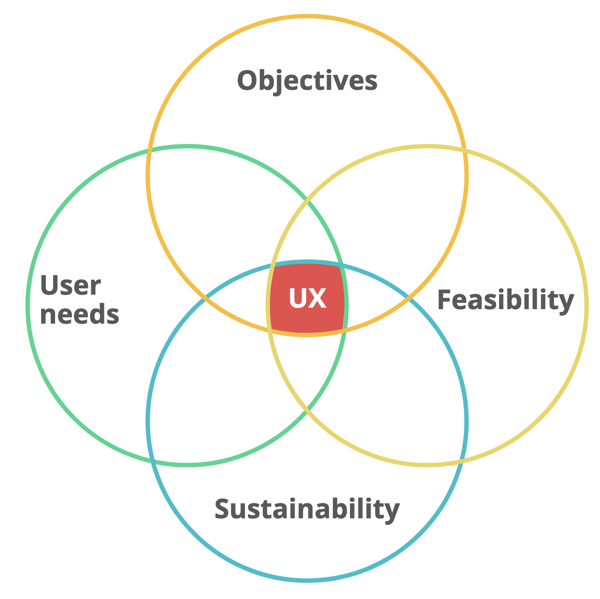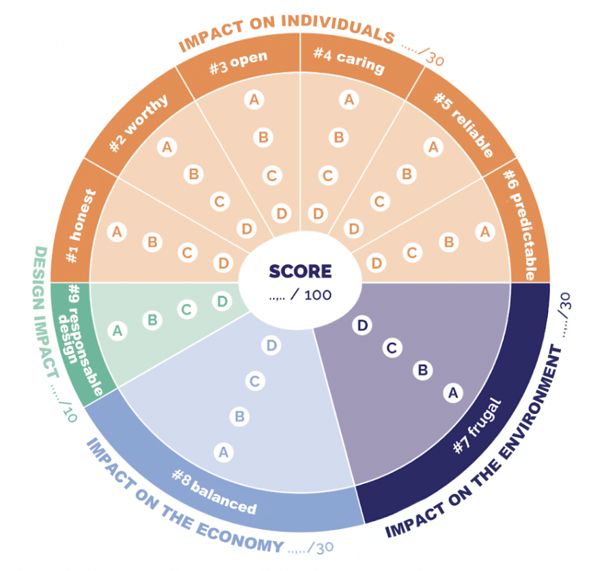February 24, 2023
UX for Good: eco-conception, accessibility, inclusivity, ethics
UX for Good will make it possible to have a positive approach to digital accountability, to design and develop experiences for the benefit of users, companies and society.
If, like us, you tend to see the glass half full, you will find that having a positive impact can also be a source of development. Thus, if you manage to include people affected by a “dys” disorder, your performance with this population will be increased tenfold beyond the improvements you make to your UX in general.
For honesty, reliability and predictability, we find notions related to ethics in digital technology. The actions you can take to be honest revolve around the issue of digital consent. It is important to bring the question of consent back to the forefront, in particular by providing clear visibility on the use of user data. It is also essential to give the user explicit control over their actions.
For example, facilitating acts of termination of subscriptions or registrations and explaining the T&Cs can be concrete actions to improve the user experience. It is also important to be transparent in communicating with Chatbots and to clarify their use.
UX for Good: why bother?
By simplifying as much as possible, the UX approach aims to reconcile the objectives of the company and the expectations of its end users. Curiously, and although it is inherently holistic, it is often treated separately from CSR or CDR (Corporate Digital Responsibility) topics. Through the projects entrusted to us by our clients, we have noticed that this situation is changing and that is good, as these 4 figures show:-
4% of global greenhouse gas emissions are due to digital technology, the equivalent of air traffic.
Source: Shift Project -
97 Zettabytes of data created, captured, copied and consumed worldwide in 2022 compared to 2Zo in 2010 and a projection of 181Zo in 2025 (1Zo = 1,000 billion GB).
Source: Statista -
6.3% of the UK population does not have access to the internet or does not know how to use digital tools.
Source : Office for National Statistics -
10% of the UK population is affected by one or several "dys" disorders
(ex: dyslexia, dyspraxia...).
Source : gov.uk
If, like us, you tend to see the glass half full, you will find that having a positive impact can also be a source of development. Thus, if you manage to include people affected by a “dys” disorder, your performance with this population will be increased tenfold beyond the improvements you make to your UX in general.
Digital responsibility digital vs. UX for Good
So why not just talk about digital responsibility, a pre-existing concept? There are two reasons that lead us to offer a more global approach of UX for Good:- By explicitly integrating the UX function, we recognize that it is an essential player in positive impact changes. This avoids referring the subject to the IT department for data centers, IT for computer equipment, etc.
- Even if this should not be the case, the responsible digital approach tends to focus on the environmental dimension of the impacts. By nature, UX seeks to remain transversal and allows for the maintaining of a balance with elements of ethics, accessibility and inclusivity.
Transversal in essence, the UX approach makes it possible to design and deploy experiences that meet the company's objectives, user expectations, sustainability requirements while remaining realistic technically, legally, etc.
It is easy to sense the extent to which the experiences we shape have an impact on the daily lives of individuals and on our footprint, particularly ecological ones. But what can we do about it?
Designing for positive impact: is it possible for digital professionals?
Yes, and much easier than you think! You don't have to completely change your business model to have a positive impact. If you have operational decision-making capability, you can already have a significant impact, such as file size or highlighting appropriate content for users. Everyone can contribute to these changes, whether on the side of strategy, design, technical or marketing.
The message we want to convey is that everyone is capable of changing things on their own scale. For the creation of a responsible digital experience, it is essential to take a step back by defining the nature of your experience. This involves listing and designating the behaviors that your product or service will have. Everyone on the design team can impact those choices, whether strategic, design, technical, or marketing. The choices you make will have an impact and it is possible to anticipate them. There are several models for this, of which there is an illustration with the framework offered by Thiga:
The message we want to convey is that everyone is capable of changing things on their own scale. For the creation of a responsible digital experience, it is essential to take a step back by defining the nature of your experience. This involves listing and designating the behaviors that your product or service will have. Everyone on the design team can impact those choices, whether strategic, design, technical, or marketing. The choices you make will have an impact and it is possible to anticipate them. There are several models for this, of which there is an illustration with the framework offered by Thiga:
In our webinar “UX for Good: when the user experience cares about ecology, inclusivity, ethics”, we present to you in a more practical way the different components and good practices of a positive impact experience among which we will find:
- The responsible or ethical aspect,
- eco-conception,
- accessibility and inclusivity.
Responsible, ethical and sustainable design
We have highlighted three behaviors for a responsible digital experience: honesty, reliability and predictability. What for? Because these are behaviors you can easily take action on.For honesty, reliability and predictability, we find notions related to ethics in digital technology. The actions you can take to be honest revolve around the issue of digital consent. It is important to bring the question of consent back to the forefront, in particular by providing clear visibility on the use of user data. It is also essential to give the user explicit control over their actions.
For example, facilitating acts of termination of subscriptions or registrations and explaining the T&Cs can be concrete actions to improve the user experience. It is also important to be transparent in communicating with Chatbots and to clarify their use.
With regard to data reliability, it is important to clearly present and explain a GDPR policy and authorize requests for access to device functionalities. These simple actions can help improve user experience and make businesses more responsible. In summary, it is important to understand that everyone can contribute to creating a positive user experience by focusing on the details and acting responsibly and ethically.
Eco-design: design case study for civic engagement
We have already spoken in this blog about eco-design. For this article, let's take a look at a customer case. Ferpection supported the launch of the Nowü media by France Télévisions and its German counterpart, Westdeutscher Rundfunk, with the aim of raising awareness among a young target audience of the environmental impact and reducing the company's carbon footprint. There is a strong predominance of "green IT" solutions in this project, i.e. the use of practices and design methods that reduce carbon consumption, such as the management of servers, storage, the weight of pages and images. To achieve this goal, we have involved users in the design stages to find a balance between their expectations - for such media to be interesting and engaging - and the environmental impact.
Inclusivity and accessibility
We tend to approach these two topics as a whole. Indeed, Ferpection participated with the AFNOR agency in a working group to define a guide on digital inclusivity. According to the definition agreed with the working group, digital inclusivity aims to allow each individual to be able to make full use of digital technology, regardless of their situation, functional, cognitive, linguistic or emotional needs.
Creating inclusively means responding to the needs of all people, regardless of background and situation. It is not only a question of following accessibility rules, but of taking into account all the specificities of each one. However, accessibility rules are essential good practices and a first step towards inclusivity.
There are three main areas in which it is possible to provide quick solutions in terms of accessibility: visual, motor and cognitive.
Creating inclusively means responding to the needs of all people, regardless of background and situation. It is not only a question of following accessibility rules, but of taking into account all the specificities of each one. However, accessibility rules are essential good practices and a first step towards inclusivity.
There are three main areas in which it is possible to provide quick solutions in terms of accessibility: visual, motor and cognitive.
- For visual solutions, this means making it easier for participants to read by modifying color contrast, line spacing or text size.
- For motor solutions, it is important to allow people with motor disorders to navigate correctly on a site. The first actions to be implemented should be the management of clickable areas.
- Cognitive solutions, for their part, consist of adapting the level of language, the typographic choice and the content to one's device, among other things.
In short, there are many concrete actions that can be put in place to design in an inclusive way.
UX Research and UX for Good
Our gut feeling: we are moving towards business models focused on impact. As many organizations are not yet user-centric, this may seem counter-intuitive or too out of step. However, we are convinced that this convergence will take place, that users and companies want to generate more and more of a positive impact. The path remains unclear, but we are confident that we will discover it together very soon!
A company with a mission, Ferpection is committed, by improving user experiences, to generating a positive impact for businesses, society and the planet. Do not hesitate to contact us to discuss your UX projects.
A company with a mission, Ferpection is committed, by improving user experiences, to generating a positive impact for businesses, society and the planet. Do not hesitate to contact us to discuss your UX projects.
All articles from the category: UX For Good | RSS


